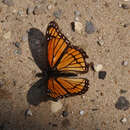pt-BR
nomes no trilho de navegação


The scientific community is divided on whether the viceroy is a Batesian mimic (a butterfly that is palatable, but mimics an unpalatable species to avoid predation) or a Mullerian mimic (a mimicry involving two unpalatable species). A recent study has shown the viceroy is less palatable than either of the species it mimics, the monarch and queen butterflies, meaning those species most likely benefit more from the mimicry than the viceroy.
The viceroy has a wide range and is not threatened.
US Federal List: no special status
CITES: no special status
State of Michigan List: no special status
Larvae feed on various types of willows and poplars. Viceroys produce three generations per year, and the food habits of each generation differs. The first brood consume carrion, decaying fungi, and animal dung. Later generations are more often observed at flowers of plants, such as joe-pye weed, aster, Canada thistle, shepherd's needle, and goldenrod. This difference is likely due to the colder, wetter conditions experienced by the first generation.
The viceroy ranges from central Canada through the eastern United States, into the Cascade Mountains and northern Mexico.
Biogeographic Regions: nearctic (Native )
Viceroys prefer open or slightly shrubby areas that are wet or near water. These include wet meadows, marshes, ponds and lakes, railroad tracks, and roadsides.
Terrestrial Biomes: forest ; mountains
Aquatic Biomes: lakes and ponds; rivers and streams
In areas of the viceroy's range where monarchs are common, the viceroy tends to mimic the pattern of the monarch (Danaaus plexippus) with black striping and orange areas similar to a monarch. The viceroy can be distinguished from the monarch, however, by one row of white spots within the black fore and hind wing bands. In areas inhabited by the Queen (Danaus glippus), the white spotting of the viceroy becomes less noticeable, and the orange coloration is replaced by a deep mahogany brown.
Other Physical Features: ectothermic ; bilateral symmetry
Mating occurs in the afternoon, and the female is the egg carrier. She deposits one egg onto the tip of a leaf and chooses only leaves that have not been eaten by other insects. She deposits about three eggs per sapling.